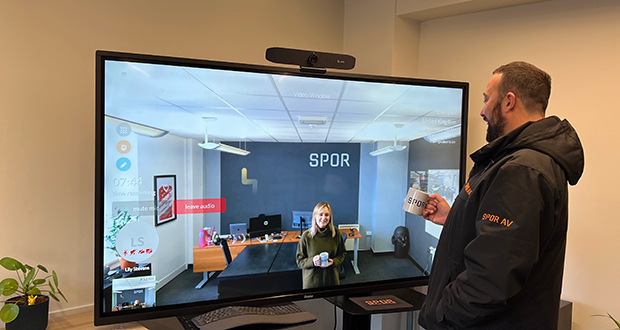Video Window, which connects workers in one office with those in another or at home, has attracted more than 100 integrator partners and will be seen on the Clevertouch stand at ISE.

Video Window software is to be exhibited at ISE 2023 on the Clevertouch stand (2N400), where a Video Window will connect back to all of Clevertouch’s showrooms in the UK.
Video Window software acts like a window into an office, enabling workers in other offices or at home, to feel connected to those who can be seen through the window and to communicate with them at will.
While well-known for its work in facilitating a high-tech portal between two sites in Lithuania and Poland, Video Window has also amassed a following among more than 100 AV integrators across the world. Integrators are able to resell Video Window licences and receive recurring revenue plus their own margin on the hardware that supports the Video Window.
Prominent workplace technology integrators who have become Video Window resellers include AVI-SPL, Kinly, New Era, Softcat, WWT and Aura with end customers including Netflix, Lockheed Martin Space, ABB, Glaukos and BP.
Well-known companies within the trade that have adopted Video Window for use internally include iiyama, Clevertouch, AVI-SPL, SPOR Group, WWT, and Project Audio Visual.
To make a Video Window feel immersive, it is recommended that it be shown with a 65″ or 75″ display in landscape mode or a 55″ display in portrait, but some customers have chosen a larger screen at 85″ or even 96″ or have gone smaller with 27″ all-in-one PCs.
“There is no official upper-limit on screen size. We’ve always loved the idea of a wall-sized Video Window and will be building a UI specifically for this,” says Daryl Hutchings, CEO of Collaboration Squared, the company behind Video Window.
Resolution is currently capped at 720p, but 1080p is expected to be released at the end of the month, and 4K is in sight in the future.
A Video Window screen is best mounted at around six feet high – not so high that it gives the camera mounted with the screen a God’s eye view, nor so low that it cuts off the heads of extremely tall people.
It is recommended that AI video features are turned off with Video Window, while AI audio features remain in use.
“We recommended turning off the AI for a few reasons,” says Hutchings. “We don’t want to be creepy and for people to feel like AI is analysing them. Auto-framing is actually distracting in a Video Window scenario as people are always walking past the device. And in the true vision of being a window, you see a fixed view out of a real window, and this give the best perception of extending physical space.”
Possibilities currently being looked at include the idea of adding an avatar-based webcam feed for Video Window Remote for home users using iPads and tablets.
Reference : AVinteractive

